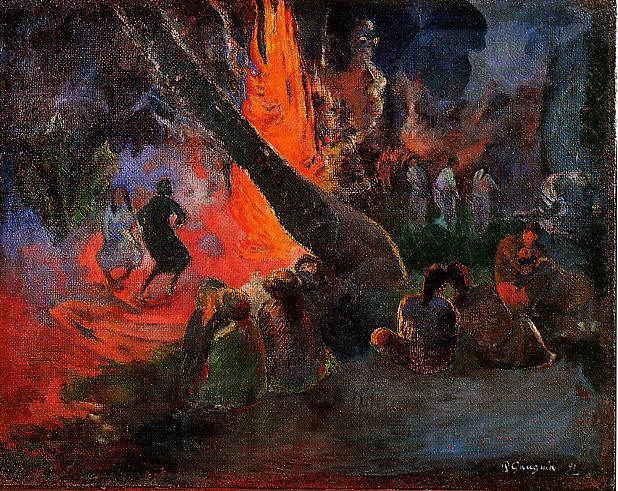Description
Paul Gauguin's painting "Fire Dance" (1891) is a work that encapsulates the essence of his stylistic and spiritual quest during his stay in Tahiti. Gauguin, known for his ability to transform reality into an almost dreamlike experience, captures in this work a scene evoking a vibrant cultural celebration. The composition shows a group of dancing figures, probably Tahitian, gathered around a campfire, from which orange and yellow flames emanate, contrasting with the blue shadows of the surroundings.
One of the most striking features of “Fire Dance” is the color palette used by Gauguin. This chromatic vividness, combining warm and cool tones, not only brings dynamism to the scene, but also reflects his interest in exploring the emotional perception of color. The figures in the foreground have marked contours and are represented with a simplification that accentuates their presence, giving them an almost sculptural character. The bodies, mostly nude, exhibit a sense of freedom and connection with nature, a recurring theme in Gauguin’s work. His application of the loose brushstroke technique reinforces texture and movement, suggesting the energy of dance and the heat of fire.
The characters in the work are central to the visual narrative, representing not only the dancers, but also a deep connection to the cultural traditions of Polynesia. Each figure seems caught up in a transcendental fervour, symbolising not only the ritual of dance, but also a sense of community and collective celebration. The closeness of the bodies in the composition suggests an intertwining, emphasising the idea of unity in cultural experience, while the glow of the fire lends them an almost mythical aura.
It is interesting to note that this work was created at a time when Gauguin was seeking to escape the materialism of European life and explore more primitive and spiritual ideals. His exploration of symbolism and use of color becomes a statement of his deeper artistic intentions, where the artist does not simply seek to depict a scene, but to imbue it with emotional and spiritual charge. The “Fire Dance” is, in many ways, a manifestation of his desire to rediscover an authentic connection with the primordial.
When comparing Fire Dance to Gauguin's other works, such as Where Do We Come From? What Are We? Where Are We Going?, one can see an evolution in his search for meaning and in his interpretation of space and the human figure. While in later works the narrative becomes a canvas for more complex philosophical questions, in Fire Dance the narrative seems celebratory and almost festive, reflecting a joie de vivre rooted in Tahitian culture.
In sum, “Fire Dance” is a work that resonates with Gauguin’s aesthetic and spiritual ideals. Its manipulation of color, its meaningful composition, and its depiction of human figures in a moment of collective celebration all frame the essence of his artistic journey, always seeking something beyond mere representation: a visceral connection to the culture and spirit of a place. This canvas does not simply capture a moment, but invites the viewer to share an experience that transcends time and space, a testament to the power of art to unite and celebrate humanity.
KUADROS ©, a famous painting on your wall.
Hand-made oil painting reproductions, with the quality of professional artists and the distinctive seal of KUADROS ©.
Painting reproduction service with satisfaction guarantee. If you are not completely satisfied with the replica of your painting, we will refund 100% of your money.

